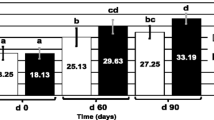Abstract
The consumption of private hold poultry foodstuffs, escaping of official maximum residue limit (MRL) controls in the commercial foodstuff, is an important exposure way for the local populations to chlordecone on the French West Indies. Therefore, chlordecone contamination of different tissues in 42 birds from 32 private holders was determined depending on the contamination of the soil of the outside plot but also surveying the rearing practices of these holders of both islands. Chlordecone contents in tissues increased rapidly with this of the topsoil of the site. The most sensitive tissues to chlordecone presence were egg yolk and liver, followed by abdominal fat and finally leg tissue. The rearing practices varied between the surveyed private holders of both islands. Nevertheless, practices for the distribution of feed and water as well as covering of soil were hardly protective, what would increase the exposure risk of these birds to this potentially present soil-bound contaminant. Although depuration of birds seems possible, the ongoing modelization of the necessary time to meet MRL thresholds indicates that such time lapse seems hardly compatible with acceptable delays for private holders. Therefore, very protective rearing practices are the main way to obtain poultry foodstuffs compliant to MRL, what seems possible if the topsoil is contaminated at less than 0.1 mg kg−1 and perhaps up to 0.5 mg kg−1 if protective practices vis-a-vis of soil exposure are very strict. Nevertheless, a higher contamination of the topsoil seems not compatible with compliant poultry foodstuffs.


Similar content being viewed by others
References
Belfiore CJ, Yang RSH, Chubb LS, Lohitnavy M, Lohitnavy OS, Andersen ME (2007) Hepatic sequestration of chlordecone and hexafluoroacetne evaluated by pharmacokinetic modelling. Toxicology 234:59–72
Cattan P, Clostre F, Charlier JP, Letourmy P (2019) A conceptual model of organochlorine fate from a combined analysis of spatial and mid-to long-term trends of surface and ground water contamination in tropical areas (FWI). Hydrol Earth Syst Sci 23(2):691–709
Clostre F, Letourmy P, Thuriès L, Lesueur-Jannoyer M (2014) Effect of home food processing on chlordecone (organochlorine) content in vegetables. Sci Total Environ 490:1044–1050
Cohn WJ, Boylan JI, Blanke RV, Fariss MW, Howell JR, Cuzelian PS (1978) Treatment of chlordecone (Kepone) toxicity with cholestyramine. Results of a controlled clinical trial. N Engl J Med 298:243–251
Delannoy M, Yehya S, Techer D, Razafitianamaharavo A, Richard A, Caria G, Baroudi M, Montarges-Pelletier E, Rychen G, Feidt C (2018) Amendment of soil by biochars and activated carbons to reduce chlordecone bioavailability in piglets. Chemosphere 210:486–494
Delannoy M, Techer D, Yehya S, Razafitianamaharavo A, Amutova F, Fournier A, Baroudi M, Montarges-Pelletier E, Rychen G, Feidt C (2020) Evaluation of two contrasted activated carbon-based sequestration strategies to reduce soil-bound chlordecone bioavailability in piglets. Environ Sci Pollut Res in press
Fournier A, Feidt C, Travel A, Le Bizec B, Venisseau A, Marchand P, Jondreville C (2012) Relative bioavailability to laying hens of indicator polychlorobiphenyls present in soil. Chemosphere 88:300–306
Fournier A, Martin O, Travel A, Puillet L, Feidt C, Jondreville C (2015) Modeling PCB transfer into hen eggs: influence of physiological characteristics of the animal. Environ Toxicol Chem 34:173–183
Galan V, Duflot B, Julien L (2008) Panorama des filières animales et typologie des systèmes d’explotations avec élevage de Guadeloupe. Insitut d’élevage, Réseau de références POSEI France, p 63
Jondreville C, Travel A, Besnard J, Feidt C (2010) Intake of herbage and soil by free-range laying hens offered a complete diet compared to a whole-wheat diet. XIIIth European Poultry Conference, Tours, France, 23-27 August
Jondreville C, Bouveret C, Lesueur-Jannoyer M, Rychen G, Feidt C (2013) Relative bioavailability of tropical volcanic soil-bound chlordecone in laying hens (Gallus domesticus). Environ Sci Pollut Res 20:292–299
Jondreville C, Fournier A, Mahieu M, Feidt C, Archimède H, Rychen G (2014a) Kinetic study of chlordecone orally given to laying hens (Gallus domesticus). Chemosphere 114:275–281
Jondreville C, Lavigne A, Jurjanz S, Dalibard C, Liabeuf JM, Clostre F, Lesueur-Jannoyer M (2014b) Contamination of free-range ducks by chlordecone in Martinique (French West Indies): a field study. Sci Total Environ 493:336–341
Jurjanz S, Clostre F, Godard E (2017) Risques de contamination des volailles en élevages familiaux par la chlordécone. Rapport d’étude ARS Martinique (France), p 45
KANNARI (2017) Exposition des consommateurs des Antilles au chlordécone, résultats de l’étude Kannari. Rapport d’expertise collective. Anses, Paris, p 159
Levillain J, Cattan P, Colin F, Voltz M, Cabidoche YM (2012) Analysis of environmental and farming factors of soil contamination by a persistent organic pollutant, chlordecone, in a banana production area of French West Indies. Agric Ecosyst Environ 159:123–132
Snegaroff J (1977) Les résidus d’insecticides organochlorés dans les sols et les rivières de la région bananière de Guadeloupe. Phytiatrie-Phytopharmacie 26:251–268
Soine PJ, Blanke RV, Schwartz CC (1984) Isolation of chlordecone binding proteins from pig liver cytosol. J Toxicol Environ Health 14:305–317
Stafford CJ, Reichel WL, Swineford DM, Prouty RM, Gay ML (1978) Gas–liquid chromatographic determination of kepone in field-collected avian tissues and eggs. J Assoc Off Anal Chem 61:8–14
Vincent J, Camy D, Thalmensi G, Julien M, Ledrans M, Quénel P, Blateau A, Godard E (2011) Le programme de santé des jardins familiaux en Martinique. Environnement Risque Santé 10:395–403
Walzem RL (1996) Lipoproteins and the laying hen: form follows function. Poult Avian Biol Rev 7:31–64
Woignier T, Clostre F, Macarie H, Jannoyer M (2012) Chlordecone retention in the fractal structure of volcanic clay. J Hazard Mater 241–242:224–230
Author information
Authors and Affiliations
Corresponding author
Additional information
Responsible editor: Philippe Garrigues
Publisher’s note
Springer Nature remains neutral with regard to jurisdictional claims in published maps and institutional affiliations.
Rights and permissions
About this article
Cite this article
Jurjanz, S., Fournier, A., Clostre, F. et al. Control of poultry contamination in chlordecone-contaminated areas of the French West Indies. Environ Sci Pollut Res 27, 41117–41121 (2020). https://doi.org/10.1007/s11356-020-08172-x
Received:
Accepted:
Published:
Issue Date:
DOI: https://doi.org/10.1007/s11356-020-08172-x




